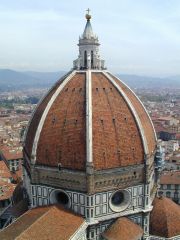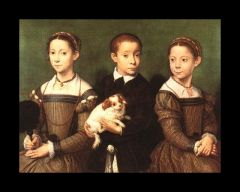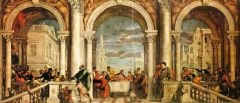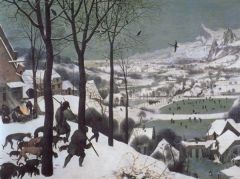![]()
![]()
![]()
Use LEFT and RIGHT arrow keys to navigate between flashcards;
Use UP and DOWN arrow keys to flip the card;
H to show hint;
A reads text to speech;
24 Cards in this Set
- Front
- Back

|

1) The Duomo
architect: Brunelleschi location: Florence period: Early Renaissance date: 1420-1436 The main body – nave, transept and choir – of the Florence cathedral was built during the Gothic period, but no architect could solve the problem of how to build a dome big enough to cover the crossing until Brunelleschi came up with is unique design involving an inner and outer dome of brick tied together by massive sandstone beams. The heavy stone lantern, affixed according to Brunelleschi’s plan after his death, helps stabilize the dome. The completion of the dome created a point of civic pride for the Florentines, and reinforced the Renaissance idea that man could accomplish anything. |
|

|
3) Palazzo Medici-Riccardi
architect: Michelozzo di Bartolommeo location: Florence period: Early Renaissance date: 1444 A typically fortress-like Florentine palazzo, with a rusticated first floor designed as a warehouse, the second floor reserved for the public salons and the top floor for private, family use. Sets the basic architectural vocabulary for financial institutions to come. |
|

|
4) Church of Sant’ Andrea
architect:Alberti location: Mantua period: Early Renaissance date: 1470 Combines classical idioms – Roman barrel vault and coffered ceiling with Greek pediment. Finished after Alberti’s death – his plans so good it was possible to do so. Inside, no aisles, only a deep, wide nave with a barrel vault. |
|

|
) Tempietto
architect: Bramante location: Rome period: High Renaissance date: 1502 Commissioned by Isabella and Ferdinand to commemorate the spot upon which St. Peter was crucified, the Tempietto marries various elements of classical design to a Christian purpose. Renaissance elements include: reference to classical Greek tholos; use of Doric order, metopes and triglyphs; geometric forms, such as circle, used for both aesthetics and function; minimal surface decoration; sculptural use of architectural components. The Tempietto is rational, harmonious, symmetrical. |
|

|
Saint Peter’s
architect: Michelangelo location: Rome period: Late Renaissance date: 1546-1564 Pope Julius initiated a complete rebuilding of St. Peter’s in 1506, hiring Bramante to create a new design. Bramante’s central plan, with a dome as large as the Pantheon’s, was modified by Michelangelo into a Greek cross, keeping the original central piers (and thereby keeping the dome the same size). In the Baroque period, the nave was vastly extended and a new façade created by Borromini – more on this later. |
|

|
La Zecca and the State Library
architect: Sansovino location: Venice period: Late Renaissance date: 1535-1545 (La Zecca) begun 1536 (library) Sansovino was the chief architect for the republic of Venice. He trained originally as a sculptor, but after fleeing to Venice from the sack of Rome in 1527, he turned to architecture. La Zecca, the Mint, was the largest public commission Sansovino received. It’s imposing façade and heavy rustication recalls the Florentine palazzos of the previous century, perhaps because it has a similar function, as a bank. The building next to it, the State Library, has much more grace and beauty. It uses the vocabulary of the Greek temple – besides the columns and arcades, it uses a classical frieze atop each story. And, like Bramante’s Tempietto, it’s crowned with a balustrade and statues, lightening the whole. |
|

|
Villa Rotonda
architect: Palladio location: Vicenza, Italy period: Late Renaissance date: 1566-1570 The prototype for Neo-Classical buildings, the Villa Rotonda is perfectly balanced: • central plan with domed interior • façade same from all four sides • each side has steps & is an entryway Translates central plan architecture into residential architecture. Palladio builds many similar villas in the countryside of the Veneto for Venetian nobility. |
|

|
West Façade of the Louvre
location: Paris architect: Pierre Lescot (sculpture = Jean Goujon) date: begun 1546 The original stronghold was constructed in the early years of the 13th century by Philippe Auguste, but Francis I razed the Norman donjon in 1528 to make way for a lighter, more elegant palace. He kept the basic plan of four wings surrounding a square courtyard, but modeled the building after a classic Italian Renaissance palazzo. The architect was Pierre Lescot and sculptural details were added by Jean Goujon. We know the courtyard façade and the Salle des Caryatides was fully functional by 1558, because the wedding of the dauphin and Mary Stuart was held there. The rest of the Cour Caree was completed during the reign of Francis’ successor, Henri II, who insisted even more emphatically on the Italian style. Hence we have a building with clear classical influences – the Roman arches on the first story, the pediments above the windows, the pilasters between the windows, the markedly horizontal symmetry. The roof, however, and the jutting pavilions, are distinctly French. |
|

|
Virgin of the Rocks
artist: Leonardo da Vinci period: High Renaissance date: 1485 This painting sets a standard for similar paintings to follow: • use of sfumato – the hazy atmosphere • modeling of figures by use of light • pyramidal composition • amazing psychological complexity revealed in figures’ interactions |
|

|
David
artist: Michelangelo period: High Renaissance date: 1501-1504 Originally intended to stand high up on the façade of the Duomo, Michelangelo’s David exhibited such intensity and power, the Florentines insisted it stand as a monument to their achievements in the Piazza della Signoria. They even gave a name to the statue’s expression: terribilita. Unlike other renderings of David, this statue shows the Biblical hero just before he slays Goliath. |
|

|
Ceiling of the Sistine Chapel
artist: Michelangelo period: High Renaissance date: 1508-1512 Michelangelo’s painting of the Sistine Chapel overall shows his focus on the human figure as the expressive force; his sculptural draftsmanship yet use of vivid color; his unique approach to Biblical narrative. The Adam & Eve panel in particular is noteworthy for: • the physicality of the figures • their natural movement • the dramatic moment • the physical proximity of the figures – like Botticelli’s Venus & Mars, these are lovers • the combination of menace and humanity in the snake |
|

|
School of Athens
artist: Raphael period: High Renaissance date: 1509-1511 One of four frescoes painted by Raphel in the Stanza della Segnatura, the Pope’s library, under a commission from Julius II. Each painting represents a different aspect of human endeavor: Theology, Law, Poetry and Philosophy. In this painting, Raphael divides the empirical philosophers (led by Aristotle) from the metaphysicists (led by Plato), including himself among those who favor evidence gathered through scientific and mathematical reasoning. The painting is a fitting tribute to Pope Julius, whose qualities we might note include: • choice of a name meant to recall not saints but Julius Caesar – one of the greatest Roman commanders and the man who declared himself emperor • the art he commissioned was designed to reinforce the papal authority • his building projects & military campaigns were expensive, leading to the Reformation |
|

|
Madonna of the Meadows
artist: Raphael period: High Renaissance date: 1505 Raphael used the pyramidal composition of Leonardo’s Virgin of the Rocks. He has also used the subtle chiaroscuro we saw in Leonardo’s drawing of the Virgin and Child. However, the landscape is more precise in terms of mathematical perspective – like a Perugino painting – instead of the atmospheric perspective preferred by Leonardo. Some of the qualities of this painting that make it demonstrably a Renassiance work: • naturalism of the figures – modeled, 3-D with realistic looking clothing • pyramidal composition • landscape setting • fact that it is painted in oils • deeply recessive space and mastery of perspective • the fact that the Christ Child looks like a real baby and is naked • the nearly non-existent halo |
|

|
Pastoral Symphony
artist: Giorgione period: High Renaissance date: 1508 Besides showing the emphasis on color instead of draftsmanship, this painting introduces: enigmatic pastoral themes; sensuous nude female figures; an appreciation of nature in landscape painting. These three qualities Giorgione bequeaths to his successors in the Venetian school. |
|

|
Madonna of the Pesaro Family
artist: Titian period: Renaissance date: 1519-1526 This painting is both typical of the Venetian colorist school, and a precursor to the Baroque. Titian has used an asymmetrical composition, placing the Madonna and Child at the upper right, which creates a diagonal, dynamic axis. His colors are remarkably vivid, and the light source from above illuminates the figures as if they were onstage. The figures are unusual because saints from different epochs are gathered together in what is termed the sacra conversione, or sacred conversation. |
|

|
) Descent from the Cross
artist: Pontormo period: Mannerism date: 1525-8 • highly dramatic moment • no focal point • whirling motion • dissonant, not harmonious • contorted and disproportional figures |
|

|
Venus, Cupid, Folly & Time
artist: Bronzino period: Mannerism date: 1546 An allegorical discussion of the folly of love, illustrating the saying: “in the end, time will uncover all.” Besides noting that the figures are allegorical – Venus, Cupid, Father Time, Envy, Deceit and Folly (with the rose petals), you should also note that they are typical of mannerism: elongated limbs; emphasis on elegant feet and hands; smooth glowing skin; complexity of figures and distortion; no central focal point. |
|

|
) Portrait of the Artist’s Sisters & Brother
artist: Anguissola period: Mannerism date: 1555 Although contemporaneous with the Mannerists, Anguissola does not use the same techniques: no exaggerated extremities, opulent clothing, affected poses. She combines genre painting with portraiture. Remember she was mentored by Michelangelo and ended up working for the Queen of Spain for 20 years. |
|

|
Christ in the House of Levi
artist: Veronese period: Late Renaissance date: 1573 Very large painting originally depicting a Last supper. Changed under questioning from the Inquisition. Typically Venetian: opulently dressed figures, architectural setting, saturated color. |
|

|
Isenheim Altarpiece
artist: Grunewald period: Northern European Renaissance date: 1510-1515 This altarpiece was made for a hospital which specialized in skin diseases, especially Saint Anthony’s Fire – ergot poisoning. The figure of Christ is painted as if he is suffering from such a disease – his skin is grey-green and full of lesions. The artist and his patrons, the monks, felt that it would be beneficial for the dying patients to gaze on Christ and recall that his suffering was on their behalf, and that they will soon be released into eternal life where they will no longer suffer. |
|

|
Knight, Death & the Devil
artist: Durer period: Northern European Renaissance date: 1514 One of three master engravings believed to have a thematic relationship. St. Jerome in his Study refers to the religious/contemplative life; Melancolia I refers to the intellectual life; Knight, Death & the Devil to the active life. Durer’s mastery of the form is evident here in the amazing shading and details of the vegetation. It is allegorical, illustrating a quotation from the Epistles which urges the soldier of God to “put on the whole armor of God that he may be able to stand against the wiles of the Devil.” Armed with is Christian faith, the knight is riding stoically through a foreboding landscape, ignoring Death, pictured as a crowned cadaver, and the Devil, the horned creature following him. The engraving also shows the way Durer brought together northern European sensibilities with Italian, since the figure of the Knight is like an Italian equestrian portrait but the landscape is a reminder of the animism of the Germanic tribes. |
|

|
French Ambassadors
artist: Holbein period: Northern European Renaissance date: 1533 An iconic painting because it shows the eclectic worldly pursuits of two “Renaissance” men – a bishop and a nobleman, surrounded by objects indicating both physical exploration of the world and intellectual exploration of scholarly pursuits. All of that, of course, is undercut by the anamorphic image of the skull – a memento mori designed to remind the viewer not to become too attached to worldly pursuits. |
|

|
Hunters in the Snow
artist: Brueghel period: Northern European Renaissance date: 1565 Brueghel’s paintings often feature the jederman – the common man or peasant, and usually in a celebratory moment – weddings, etc. In this painting, however, he juxtaposes the lighthearted – the peasants ice skating in the far background – with the dismal – the hunters returning empty handed. The painting also has an element of the fantastic, since there were no mountains in Flanders where Brueghel lived and worked – he probably used the sketches he made while traveling through the Alps to Italy for the background to this painting. |
|

|
The Burial of Count Orgaz
artist: El Greco period: Mannerism date: 1586 The painting is based upon a legend that Count Orgaz, who had died about 300 years before the painting was made, was buried miraculously by two saints – Saint Stephen and Saint Augustine, who descended from heaven to bury the Count. The painting has two planes – an earthly plane below and a heavenly plane above. The elongated figures and bizarre composition is what labels him as a Mannerist but the swirling energy, heightened religiosity and otherworldly feel are peculiar to El Greco. |

